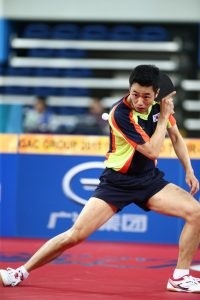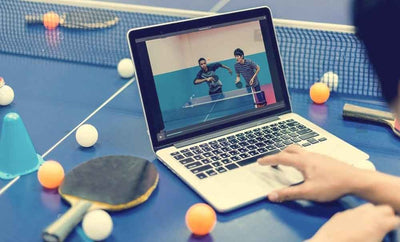
Different Kinds of Spins In Table Tennis
Spin can spell the difference between an intermediate player and an advanced player, so it is really vital to familiarize ourselves with everything there is to learn about all kinds of table tennis ball spins. Many players are so handy with engaging in rallies, doing flashier and faster shots, but always fail to handle spin or generate some on their own. And sometimes, an intermediate players’ game can seemingly look and feel as fast-paced as an advanced players’ game because the speed of the ball exchanges is relatively the same. But what really marks them off apart is the amount and quality of spin each ball carries over to and fro each end.
Topspin
Topspin is produced by brushing the ball in an upward motion. Topspin often yields high ball throw being really suitable for offensive set-ups or cheap and easy points when the ball throws off the other end.
Topspin rebounds fast and low depending on its amount and quality. An insane amount of topspin will make the ball spring forward really fast, forcing the opponent to block and give away a high and no-substance return, or to exercise a difficult counter-attack, which chances are slimmest even at professional level.
Returning a topspin
When a topspin contacts in your rubber, it will spring upward high, making it easier for your opponent to be at his offensive stance. To prevent this from happening, you should hit a topspin with a closed racket angle (again, depending on the amount of topspin loaded) either with a fast upward brushing to short-counter the ball or block.
Loop
A special kind of topspin. It is a very slow motioned ball with insurmountable amount of topspin that can be lethal for rhythmic players. A loop is dealt with a flat angle for both blocking and counter-driving.
Backspin
Backspin is produced by brushing the rubber against the ball in a downfall motion. It is most commonly used for serving and receiving subsequently. Backspin is never overused by offensive and all-around players because doing so promotes increased chances for the opponent to attack as the ball is slow and easy to eye on when in backspin. On the other hand, backspin is the main weapon of defensive players. They try to garner points by forcing offensive errors or tiring opponents with consistent backspin/ chopping.
Returning a backspin
Returning a backspin can be very tricky as failing to do it effectively may result in heightened ball placing or very low receiving, that can easily give off the point to your opponent. To effectively return a backspin, use an open angle hitting underneath the ball, doing the push stroke, or brushing the ball (again, depending on the amount of backspin present at the ball) with cautionary measures.

Sidespin
Sidespin is produced by brushing the ball in either side of the ball. Sidespins are usually used to supplement topspin or backspin to add confusion and hesitation to the opponent.
Sidespin is most common in services. This is because sidespins can be very deceiving, especially when mixed with either topspin or backspin. May it be short or long ball service, using a sidespin serve is always at the advantage. Although apart from services, sidespin is not much used anymore (except for extreme counter-rallies from end to end of the table).
Corkscrew spin
A special type of sidespin. This is a concentrated sidespin capable of making the ball trounce and kick sideways in a quick and far motion. This is usually done in snakes to disorient the rhythm of the opponent and possibly force him/her to commit offensive error.
Returning a sidespin
Receiving a sidespin has a lot of factors to consider, a lot of variations to take note of, but there are a handful of principles that can be followed to increase the chances of a quality side-spin return.
You need to observe where the contact point is upon the opponent’s racket’s contact with the ball and hit the ball in the same area as you receive it. If you are unsure of the sidespin serve your opponent did, aim for the middle of the table. In this sense, although you didn’t get to read the spin of the ball, you still have a high chance of returning the ball by aiming at the safe middle zone.
No-spin
No-spin is produced by hitting the ball in concrete contact with the ball. This is effective in faking a spinny serve, spinny loop, or spinny chop.
In faking backspin or sidespin serves, players make contact with the ball in such a way that it will seem that there is spin, heavy spin, in the ball when there actually isn’t any. Adding some visual and acting deception, the opponent is most likely to succumb to an error or a high return capable of being attacked with ease.
In loops or rallies with topspin involved, hitting the ball with no-spin will force the opponent to hit the ball insufficiently that it will send off the ball to the net.
Key points to remember to effectively read spins:
Always check the grip-level and tackiness of the rubbers your opponent is using.
Apparently, grip-level and tackiness of rubbers affect the amount of spin your opponent can generate assuming his/her fairly decent strength to brush off or play the ball with spin. So before the game starts, ensure that you have taken note of your opponent’s equipment.
Extremely tacky or Chinese rubbers can generate a way, way more insurmountable amount of spin than slick surfaced ones or European ones, which are more primed at sponge technology and bounce feel. Short-pips can generate a small amount of spin and works like a rubber, but its ball trajectory upon hitting is pointier than normal inverted rubbers. Long-pips usually reverse and lessen the ball spin upon contact depending on its usage.
Listen carefully what sound the contact of the ball and the rubber sheet made.
Sports science of table tennis revealed how most table tennis players rely on sound to determine the spin of the ball instead of actual visual observations. A crispier and harder sound means less spin and more speed while a softer and brushing sound indicates heavy spin.
Observe how the ball bounces on the table.
If you still aren’t sure about how to read a spin thoroughly, look at how the ball bounces on the table. A hasty bounce is usually due to a topspin, a dying bounce from a backspin, and sideway bounce (curving) from a sidespin.
And consequently, how the ball traverses through the air.
A ball carrying topspin will arc like a rainbow over the net, while a ball bearing backspin will float and look slower. A ball with sidespin will, apparently, bounce and fly sideways.
Take note of how your opponent [usually] hit the ball.
The last resort. If you really find it a nightmare just reading off the spin your opponent generates, take note of the most frequent manner your opponent does in spinning the ball. If you misread a spin one time, you can guess the spin the second time it comes around when you see the ball motion being already familiar.





Leave a comment